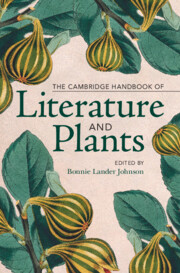Book contents
- The Cambridge Handbook of Literature and Plants
- The Cambridge Handbook of Literature and Plants
- Copyright page
- Contents
- Figures
- Contributors
- Introduction
- Part I Historical Periods
- Part II Anglophone Literary Forms
- Part III Global Regions
- Chapter 12 Plants in the French and Francophone Literary Tradition
- Chapter 13 Early American Plant Writing
- Chapter 14 Plants in the Literatures of Latin America and the Caribbean
- Chapter 15 Plants in the Literatures of Australia
- Chapter 16 Plants in the Literatures of Southern Africa
- Chapter 17 Lotus
- Chapter 18 Plants in the Literatures of India
- Chapter 19 Tree-Rings of Middle Eastern Poetry
- Select Bibliography
- Index
Chapter 15 - Plants in the Literatures of Australia
from Part III - Global Regions
Published online by Cambridge University Press: 06 February 2025
- The Cambridge Handbook of Literature and Plants
- The Cambridge Handbook of Literature and Plants
- Copyright page
- Contents
- Figures
- Contributors
- Introduction
- Part I Historical Periods
- Part II Anglophone Literary Forms
- Part III Global Regions
- Chapter 12 Plants in the French and Francophone Literary Tradition
- Chapter 13 Early American Plant Writing
- Chapter 14 Plants in the Literatures of Latin America and the Caribbean
- Chapter 15 Plants in the Literatures of Australia
- Chapter 16 Plants in the Literatures of Southern Africa
- Chapter 17 Lotus
- Chapter 18 Plants in the Literatures of India
- Chapter 19 Tree-Rings of Middle Eastern Poetry
- Select Bibliography
- Index
Summary
Australia’s botanical diversity has shaped its literature of the environment. Through a selection of novels, short stories, and poetry, this overview focuses on the literary depiction of native species such as the coolabah, paperbark, and wattle. Structured chronologically, the discussion begins with Indigenous Australian narratives of plants, arguably the world’s oldest literary representations of botanical life. In the narratives of Aboriginal and Torres Strait Islander people, plants are wellsprings of material and spiritual sustenance. Between British settlement and Federation, non-Indigenous narratives of Australian flora begin to appear. In these decades, literature negotiates the strangeness of antipodean plants in comparison to familiar European species. In post-Federation literature, the relationship between flora and nation becomes more pronounced. During this period, writers increasingly foreground the clearance of forests in the post-colonial state. Contemporary literature reveals an expanded understanding of plant ecologies and conservation realities. The work of Judith Wright and Oodgeroo Noonuccal during these years establishes a precedent for later literary activism. The Anthropocene literature of recent decades confronts humanity’s escalating impacts on plants especially in Australian regions. Literary works critique climate disturbance, habitat degradation, urban development, and related exigencies that continue to imperil the future of plants in Australia.
- Type
- Chapter
- Information
- The Cambridge Handbook of Literature and Plants , pp. 285 - 303Publisher: Cambridge University PressPrint publication year: 2025

